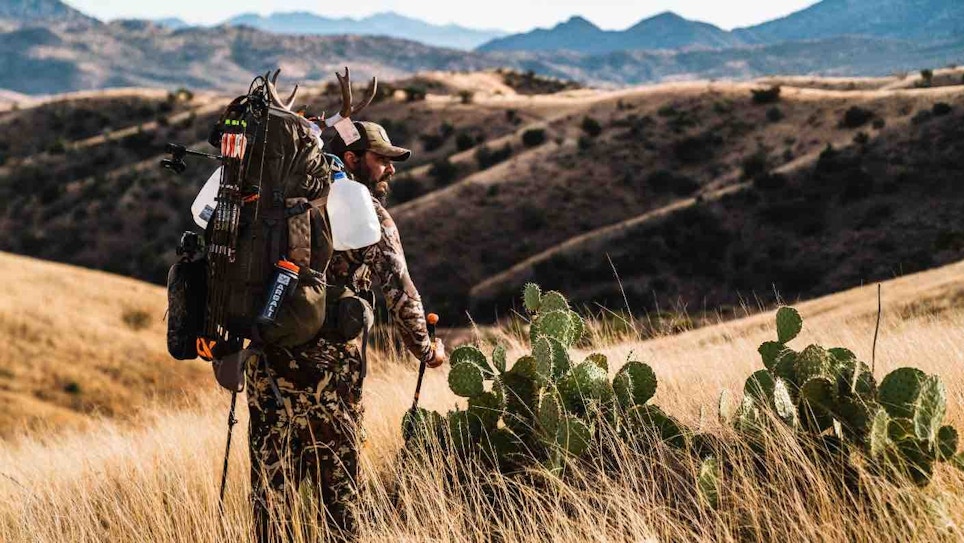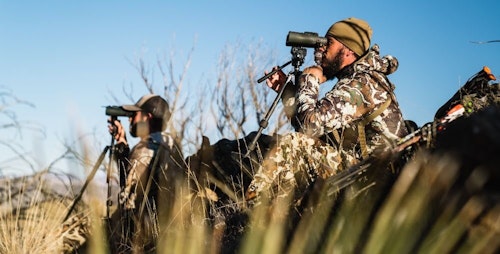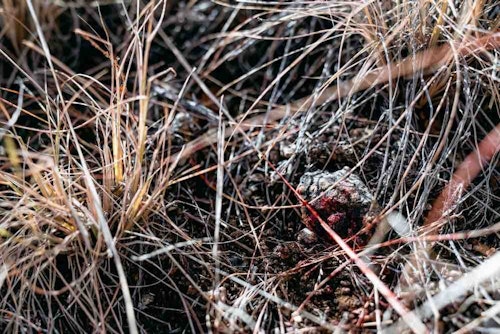
To offset having to search for water immediately, the author packs full water jugs. After he discovers a water source, he filters more for camp.
We had been watching a particular buck for days now during the heart of the Coues rut in Arizona. He was one of those deer that could simply look at other incoming bucks and they’d turn away. Up until this point I had made two stalks on him and came up empty. Well, kind of. Lessons learned is knowledge gained in bowhunting. So, with the buck in a great position on our second to last day, I was beyond ready to put that knowledge to use.
Rewind
Four days prior to this felt like Christmas morning. Every year in January a group of friends and I gather at a trailhead in Arizona to pack into the backcountry and test our luck against the gray ghost. It’s one of the only times of the year when we all see one another. So, deer or no deer, it’s always worth it. The company is soothing and the deer hunting is damn good. It doesn’t come without challenges, though.
If I’ve learned one thing about stalking Coues deer, it’s that I’m going to continue to learn way more. It is by far the best classroom for spot and stalk bowhunting. This is a deer that has mastered trickery. An artist, and I must say, I’m a big fan of their work.
I once heard a story of a Coues buck belly crawling through the tall grass past a bowhunter’s treestand until he was out of sight. They are just next level tough to get into bow range of, and they’ll take you on a roller coaster ride from top to bottom. This hunt proved that thoroughly. Class is in session.

Lesson No. 1
The first time I saw this Coues buck was on our first evening glassing session. It was about an hour before dark, and I caught movement to my left. A heavy antlered buck was chasing a doe, and I didn’t waste any time on thinking about what to do. It looked as if I’d have a perfect path to cut him off. At least I thought.
In a mad dash for daylight, I side-hilled along the rocky desert floor, serpentining my way through the thorn-choked oasis this buck called home. After rounding a bend, I realized my route had a failing point: I was visible to the deer where I thought I wouldn’t be. As it should be, the buck caught me moving and their rut party was taken elsewhere. It cost me and I never saw the buck again that day.
Lesson: Be meticulous on your stalking route. You cannot, and I mean cannot, take shortcuts with Coues deer. They will put you in your shoes time and time again if you do so. I rushed the planning here and it cost me an opportunity. Had I seen the weak point, and adjusted, the stalk might have played out differently.
Lesson No. 2
On our third morning, a stone’s throw from camp, we sat and scanned the overwhelming high desert around us, watching as the hills woke up. Sooner than later, a group of deer was spotted with a buck rutting does. After further investigation, our assumptions were correct. It was him.
This time there was no rushing. I took the time to plan my route and felt confident in it. I’d have to cross a creek below, ascend up a large face, and then side-hill into the deer. With any luck, they’d still be there upon my arrival. As luck would have it, after my short jaunt through the desert, they were.
I could see the deer trotting around on the other side of the oak brush that stood between us. The wind was great, and this was looking much better than the first stalk. They were also officially within bow range. Now, I was faced with a decision. Would I come to full draw and step out for a shot, risking being seen by other deer? Or do I stand in wait, looking for a better opportunity? My eagerness led to bending the limbs back and stepping out for a shot. Again, I was put in my place. The deer saw me and they ran out of the picture.
Lesson: Patience and aggression both have value, but each has their place. Up until stepping out from the brush, I had done everything right. My aggressive move that morning put me in front of that deer. It was absent of patience, though, which led to the death of my stalk. Spot and stalking requires several different gears to make it happen. Know the gears and use them well.

Lesson No. 3
On a distant windswept ridge before sundown, the buck showed himself again. It was the evening of our fourth day, and I couldn’t do anything about it. Having made that very stalk in the past, I knew I didn’t have time to make it happen. So, we watched him until dark. We watched how he demanded the respect of the other bucks around. The mere sight of him would send them the other way. My dreams that night would be rich with hope. And the next morning couldn’t come soon enough — which brings us back to the beginning of this article. He was indeed still there at sunup. And I was indeed ready for another go.
This time, I planned my stalk down to the tree, marking mental waypoints of where I’d really start slowing down and where I think I’d be able to see him. This was it. It was going to happen or I was going home.
The play on this old buck would be a classic loop with the hopes of me coming in from above as he pushed his does around beneath. Once I got there, I could see the does off in another area, but the buck was gone. My hunting partner was signaling to me that the buck was still there. So, I waited and waited some more.
Finally, I got antsy and started creeping, pausing often to look into every crevice. After stopping again for some time, just sitting there and looking through the brush, I decided to try something bold — the ol’ rock trick. Never before had I tossed a rock to get a bedded deer to stand, or in this case, simply to show himself. But I was willing to give it a go.
One rock went. Nothing. Another went. Again, nothing. I sent another, and then I caught movement beneath. The buck was bedded 15 yards below me under a juniper. There was no shot. All I could see were antlers. Instead of my aggression taking over like it did before, patience pushed its way into place. I’d wait above that buck for almost 2 hours before he’d stand.
The buck moved to the right and I thought I’d be able to round a tree and meet him on the other side for a 20-yard shot. I came around the trunk and didn’t see him. So, I went back to the other side of the tree and found him. He had button hooked on me, instead of going straight.
Now, with the buck standing on the hill across from me, I knew it was now or never. I drew back, tried to settle as best I could, and let it go. This was a shot at the edge of my comfort zone. The arrow hit, but I didn’t know where. I’d find out soon enough. Until then, my excitement skyrocketed; I had done it.
Lesson: What I didn’t mention here was how long I waited on that buck to walk out from the other side of the tree. It was too long. Had I assessed that situation better, I no doubt would have gotten a closer shot than the one I took. Another balancing act between patience and aggression.
Lesson No. 4
My hunting partner met me on the hill shortly after the shot. We high fived and there were smiles all around. He informed me that he saw the buck run down into a draw and never come out. Sounded great to me! After reminiscing over a snack, we started making our way toward the draw. It didn’t take long to find my arrow. Our optimism immediately faded. The red coat I dreamt of wasn’t there. This arrow wore a green coat instead, a classic sign of a gut shot.
Shortly down the trail from where we found the arrow, I actually spotted the buck bedded under the shade of a juniper tree. He was facing away at 70 yards. I had no shot here due to a large rock blocking his vitals. So, I decided to try and sneak my way down for a better angle. The buck must have heard me coming down the hill because shortly after he stood up and slowly started walking away and topped over a small ridge. At that point I felt the best thing to do was give him his space and let things take their course. It made me sick and our hike back to camp that evening felt more like a trudge than anything. Little did I know, my emotions would be toyed with even more sooner than later.
“I’ve got a buck bedded under a tree,” my hunting partner said. Being 30 minutes before dark, during the rut, this didn’t sound right to me. I got the buck in my spotting scope for a closer look and sure enough there was a blood spot on him. A tiny glimpse of light that made the evening seem not so dark. Unfortunately, all we could do at this point was watch him. Several times the buck got up, moved 10 yards, and bedded back down. He looked very sick, which made me feel awful. I had not done my job, made a bad shot, and he was suffering because of it. Sleep would not join me in my tent that night.
Lesson: As sick to my stomach as I was, there was a great lesson here. The severity of making a good shot and doing your job as a hunter. Bad shots happen, yes, but we can do things to avoid them. There is the obvious like practice, but there are also things such as self-control and empathy. Have the self-control to not shoot if the situation isn’t right. I could have felt more steady had I let down from holding at full draw. And have empathy for the animal in reflection of your actions.

Lesson No. 5
We woke early the next morning. Or in my case, I simply got out of the tent from a long night of laying there deep in thought. After breakfast and a quick glassing session at first light looking for the buck, we came up empty. It was time to go over there and start tracking.
Every bed I watched him occupy, I visited. It was crucial in staying on his track, because the buck wasn’t bleeding much. This started at the top of a ridge and led us down to the bottom of a small drainage. Honestly, it was fairly smooth sailing following his trail down here. Then we hit a wall.
For hours we went back and forth trying to find the next nugget of information, and there was nothing. Grid searching, looking for any morsel of positivity, and both of us were dumb founded. For some reason, though, call it hunter tuition, or just dumb luck, I had one last hunch. The bottom of this drainage had sand in it, which would surely show tracks very easily, so I took a look. I’m glad I did.
Not 40 yards from our last drop of blood I found fresh deer tracks, followed by a lot of blood. And not 20 yards from that I saw antlers sticking up from behind a bed of rocks. It brought me to my knees. We almost left. I thought it was over. In fact, though, we walked past the buck probably four times throughout our search earlier. Just like on a distant hillside though, he melted into his environment. Like a Coues should. Unbelievable.
Lesson: Very easily, we could have left and threw in the towel. Very. We almost did it multiple times. So, the biggest takeaway here for me was to never give up, and it’s not over until it’s over. This goes for not just trailing an animal, but for bowhunting overall, and even life in general. If you’re frustrated, take a break. Take some space. When you’re done, chin up, and get back to it.

End of the Day
Walking out of the hills that evening with my buck and camp loaded down was a weight I didn’t think I was going to feel. The sweat on my brow and burn with each step closer to the truck was a welcomed feeling. This bowhunting game we play is a wild one. It’s filled with more ups and downs than the very country we hunt.
Yes, it can get tiresome at times and wear down the best of us. Just remember there are no highs without lows, though. Valley floors are just as important as the mountains that surround them. And you’ll never achieve what you desire should you give up. Never ever give up.
Photos by Josh Kirchner





